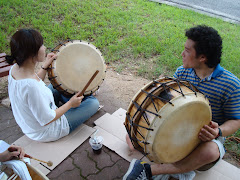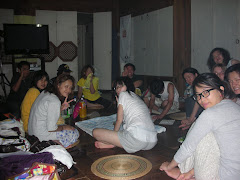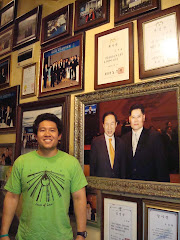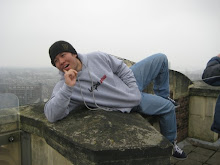I also stopped by Jogyesa Temple, the head temple of Korea's largest Buddhist sect, Jogyejong. This temple was conveniently located about five minutes away from Insa-dong market. I arrived during the middle of a Buddhist worship, and sat for a while just listening and observing the people as they sat and bowed to the great Buddha statue in the middle of the temple. What was interesting about this temple was that it stood in the heart of Seoul amongst the city's modern buildings and busy roadways. Thus, there existed a sort of clash between the surrounding modernity and Jogyesa's temples. Nevertheless, these two worlds seemed to have found a balanced relationship with each other in an ongoing coexistence.
After going through Insa-dong and the Jogyesa temple, I took about a fifteen minute walk north to Gyeongbokgung palace. I wasn't really planning on going here, but it happened to be close enough to make the trip. And it was well worth it. The palace was built in 1394 and is the oldest palace of the Choson dynasty. When I first arrived, the changing of the guards was in progress. These men were dressed in traditional clothing and guarded the front gate of the palace. They had pretty intense weaponry including a bow and long blade, and looked pretty fierce. I don't think you'd want to get in a fight with them. As I walked through the palace gates, it was as if I was being transported back in time. I had forgotten about Seoul's busy streets and modern architecture outside of the palace walls. Behind the Gyeongbokgung palace stands Cheong Wa Dae (The Blue House), the presidential residence of the Republic of Korea. It actually is blue, and is scenically placed at the base of Bukaksan mountain.
The last placed I stopped before heading back home was the Bosingak Bell Pavilion. This is the home of a massive bell that was first rung in 1394 signaling the opening of the city if I can remember correctly.
It was quite a day, and I had worked up an appetite. Luckily, by the time I had returned to my hasukjib there was a hardy meal of rice, kimchee, beef, and squid waiting on the table which Nuna had prepared :)






















































































































No comments:
Post a Comment